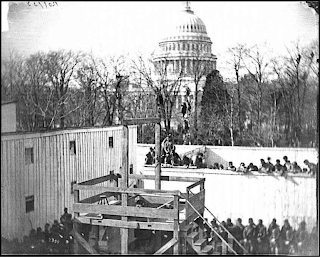 |
| Above is the Guadalcanal Island layout. As you can see, Iron Bottom Sound is to the right of Henderson Field. |
 |
| Above is Kinugawa, a Japanese cargo ship, beached and sunk on the shores of Guadalcanal. The Japanese were unable to receive supplies. |
Guadalcanal’s importance meant that fighting continued because, “neither side was willing to give up the struggle to maintain control over the Sound, and thereby denying supply to the other side's land forces” (7). The stage was set, yet again, for another brutal battle two nights later, which began the second naval battle of Guadalcanal. Americans lost three destroyers and a battle ship that evening. The Japanese had lost one additional destroyer that played an important part in taking over Henderson Field. Because of this they have finally given up the war effect to take over Henderson Field. The Campaign of Guadalcanal finally ended on February 9, 1943; the Japanese had lost 31,400 troops, whereas the U.S. had only lost 2,000 soldiers when about 60,000 were deployed (8), both sides lost a lot of ships. But by far the most significant loss for the Japanese was the decimation of their elite group of naval aviators (9). Japan, after Guadalcanal, no longer had a realistic hope of beating the all-powerful United States (10).
-Jenna S. & Jack R.
(1) "Guadalcanal Campaign," Princeton University, Accessed November 7, 2013, http://www.princeton.edu/~achaney/tmve/wiki100k/docs/Guadalcanal_Campaign.htm.
(2) Nihon Kaigun, "Guadalcanal Campaign - Nihon Kaigun," Accessed November 7, 2013, http://www.combinedfleet.com/battles/Guadalcanal_Campaign#First_Guadalcanal.
(3) “Guadalcanal Campaign – Nihon Kaigun”
(4) “Guadalcanal Campaign – Nihon Kaigun”
(5) “Guadalcanal Campaign – Nihon Kaigun”
(6) “Guadalcanal Campaign – Nihon Kaigun”
(7) “Guadalcanal Campaign – Nihon Kaigun”
(8) "Battle of Guadalcanal,” — History.com, Accessed November 7, 2013, http://www.history.com/topics/battle-of-guadalcanal.
(9) “Battle of Guadalcanal”
(10) “Battle of Guadalcanal”
(11) Naval History and Heritage Command, "Guadalcanal Campaign,” Accessed November 7, 2013. http://www.history.navy.mil/photos/events/wwii-pac/guadlcnl/guadlcnl.htm.


